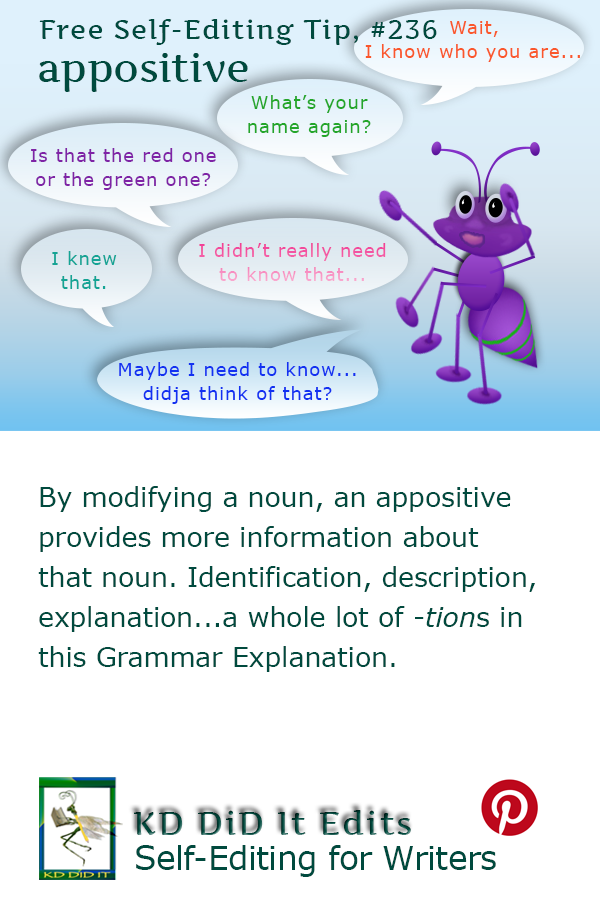Revised as of
27 Jan 2023
A single word or a phrase, appositives modify a noun by providing more information about the noun. It could be identifying, explaining, describing, and more.
Such information is usually nonessential, but creates a bigger picture for the reader. As nonessential information, it requires parentheticals to set the appositive apart from the rest of the sentence.
Sometimes the appositive is essential and the sentence would have no meaning without it, in which case, don’t use parentheticals.
Grammar Explanations is . . .
. . . an evolving list of the structural rules and principles that determines where words are placed in phrases or sentences as well as how the language is spoken. Sometimes I run across an example that helps explain better or another “also known as”. Heck, there’s always a better way to explain it, so if it makes quicker and/or better sense, I would appreciate suggestions and comments from anyone on an area of grammar with which you struggle or on which you can contribute more understanding.
If you found this post on “Appositive” interesting, consider subscribing to KD Did It, if you’d like to track this post for future updates.
Return to top or post contents
| Appositive | |||
| Definition: A noun or pronoun frequently modified/defined/identified by another noun or pronoun.
POST CONTENTS |
|||
| Appositive Phrase | |||
| Definition: The phrase usually follows the noun; sometimes it may precede the noun.
Rule: Nonessential phrases are set off with commas or some type of parenthetical. |
|||
|
Legend:
The best quilt in the show, a Baltimore Album wedding quilt, was stolen last night. My favorite exercise, canoeing along a river, is too chilly to enjoy in the winter. We saw the most incredible horses at the stock show — Tennessee Walkers. Henry’s girlfriend, Anne, came along for the ride. Well, Henry has only the one girlfriend. |
|||
| Appositives are… | |||
| After the Noun | Definition: The appositive comes AFTER the noun it explains.
Rule: Whether a comma is used to separate the appositive from the sentence depends upon if the information it provides is essential or not. |
||
|
Return to top or post contents |
Legend:
Your friend Bill is in trouble. He has more than one friend so it is essential for the friend to be named. My brother’s car, a sporty red convertible with bucket seats, is the envy of my friends. Describing “my brother’s car” is nonessential information. The chief surgeon, an expert in organ-transplant procedures, took her nephew on a hospital tour. This sentence is about taking a relative on a tour; the surgeon being an expert is nonessential information. |
||
| Before the Noun | Definition: The appositive comes BEFORE the noun it explains.
Rule: Use a comma to set off the appositive when it comes before the noun. |
||
|
Return to top or post contents |
Legend:
A bold innovator, Wassily Kadinsky is known for his colorful abstract paintings. The first state to ratify the U. S. Constitution, Delaware is rich in history. A beautiful collie, Skip was my favorite dog. |
||
| Too General, Unclear |
Definition: The noun is TOO GENERAL and additional information is required to make it clear.
Rule: Needed information, the appositive, is essential and commas are not used. |
||
|
Return to top or post contents |
Legend:
The popular US president John Kennedy was known for his eloquent and inspirational speeches. Without “John Kennedy”, we wouldn’t be able to pinpoint which president was “The popular US president known for his eloquent and inspirational speeches.” John Kennedy the popular US president was quite different from John Kennedy the unfaithful husband. Both appositives are necessary otherwise we wouldn’t understand the sentence—it would just be John Kennedy was quite different from John Kennedy. We wouldn’t know what qualities of John Kennedy were being referred to without the appositive. |
||
| Complete, Clear |
Definition: The noun is CLEAR and COMPLETE without the appositive.
Rule: When the appositive contains nonessential information, the appositive must be encased in commas. |
||
|
Return to top or post contents |
Legend:
John Kennedy, the popular US president, was known for his eloquent and inspirational speeches. Without “the popular US president”, we’d still know that “John Kennedy was known for his eloquent and inspirational speeches”. |
||
C’mon, get it out of your system, bitch, whine, moan . . . which words are your pet peeves? Also, please note that I try to be as accurate as I can, but mistakes happen or I miss something. Email me if you find errors, so I can fix them . . . and we’ll all benefit!
Satisfy your curiosity about other Grammar Explanations by exploring its homepage or more generally explore the index of self-editing posts. You may also want to explore Book Layout & Formatting Ideas, Formatting Tips, Grammar Explanations, Linguistics, Publishing Tips, the Properly Punctuated, Word Confusions, Writing Ideas and Resources, and Working Your Website.
Resources for Appositive
Some of these links may be affiliate links, and I will earn a small percentage, if you should buy it. It does not affect the price you pay.
Purdue OWL
Pinterest Photo Credits:
Ante is getting confused with all these possibilities.


